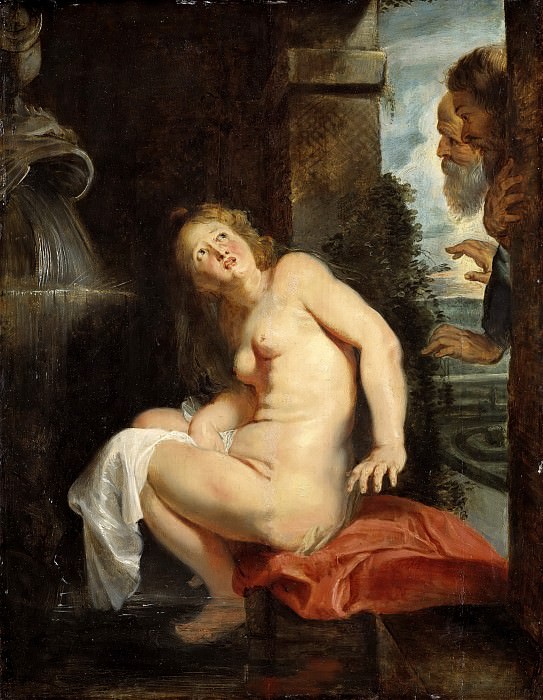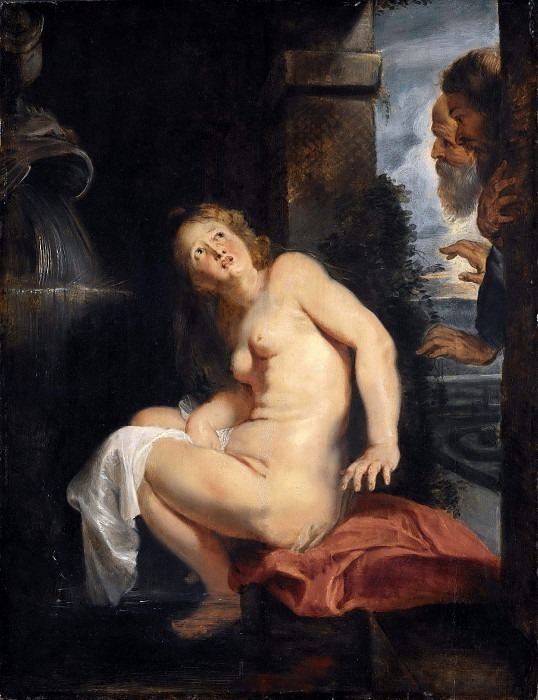

Peter Paul Rubens – Susanna and the Elders
1614. 64x46
Location: National Museum (Nationalmuseum), Stockholm.
На эту операцию может потребоваться несколько секунд.
Информация появится в новом окне,
если открытие новых окон не запрещено в настройках вашего браузера.
Для работы с коллекциями – пожалуйста, войдите в аккаунт (open in new window).
Поделиться ссылкой в соцсетях:
COMMENTS: 1 Ответы
http://sr.gallerix.ru/repository/Rubens_Susanna_Olders.jpg
2929×3816 px (1,1 Mb)
You cannot comment Why?
In this painting, titled Susanna and the Elders, a nude woman is depicted in a state of distress and vulnerability. She is shown seated on a rich red cloth near a fountain, with a white cloth draped over her lower body, suggesting she was interrupted during a bath. Her head is turned upwards, her eyes wide with a fearful and pleading expression, and her mouth is agape as if in a cry. Her body is contorted, conveying a sense of unease and a desperate attempt to protect herself.
Peeking from behind a dark architectural element on the right side of the painting are two elderly men, their faces leering and their hands reaching out towards Susanna. One mans beard is white, and the others is darker, and their expressions are suggestive of lust and predatory intent. They are positioned in such a way that they are both observers and aggressors, their presence casting a menacing shadow over Susannas privacy.
The background features a fountain with water cascading downwards on the left, a dark, shadowed area that enhances Susannas isolation. To the right, beyond the two elders, a glimpse of a formal garden with sculpted hedges and a fountain can be seen, hinting at the setting of a well-to-do private residence, which is also Susannas home according to the biblical story.
Subtexts:
The painting powerfully explores themes of virtue threatened by corruption and lust. Susanna embodies innocence and purity, caught in a moment of forced exposure and assault by figures of authority (the elders) who have abused their power and position. The stark contrast between Susannas evident distress and the elders predatory gaze highlights the injustice and violation she is experiencing.
The vulnerability of women in a patriarchal society is also a key subtext. Susannas nudity, intended for privacy, becomes the catalyst for her violation. The painting raises questions about gaze, power, and the objectification of women. Her upward-looking gaze can be interpreted as a plea for divine intervention or a desperate attempt to escape her horrifying situation.
The work also touches upon the hypocrisy of those in power. The elders, who should be wise and just, are depicted as morally corrupt, driven by base desires. Their actions underscore a betrayal of trusts and a perversion of their supposed roles within the community.
Furthermore, its a narrative of false accusation and moral judgment. In the biblical story, the elders, after failing to seduce Susanna, falsely accuse her of adultery, leading to a trial where she is nearly condemned to death. The painting captures the terrifying prelude to this ordeal, emphasizing the psychological torment and the imminent threat of shame and ruin for an innocent woman.